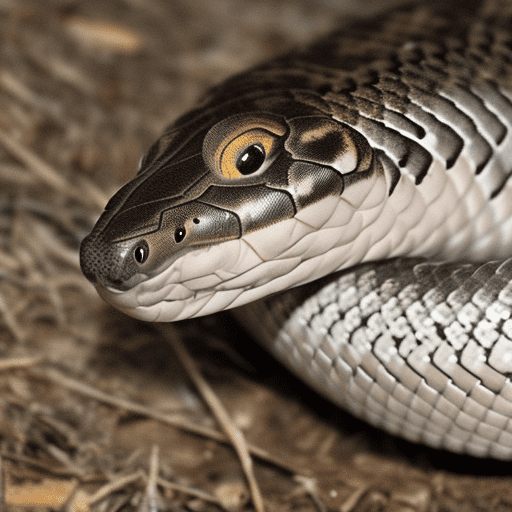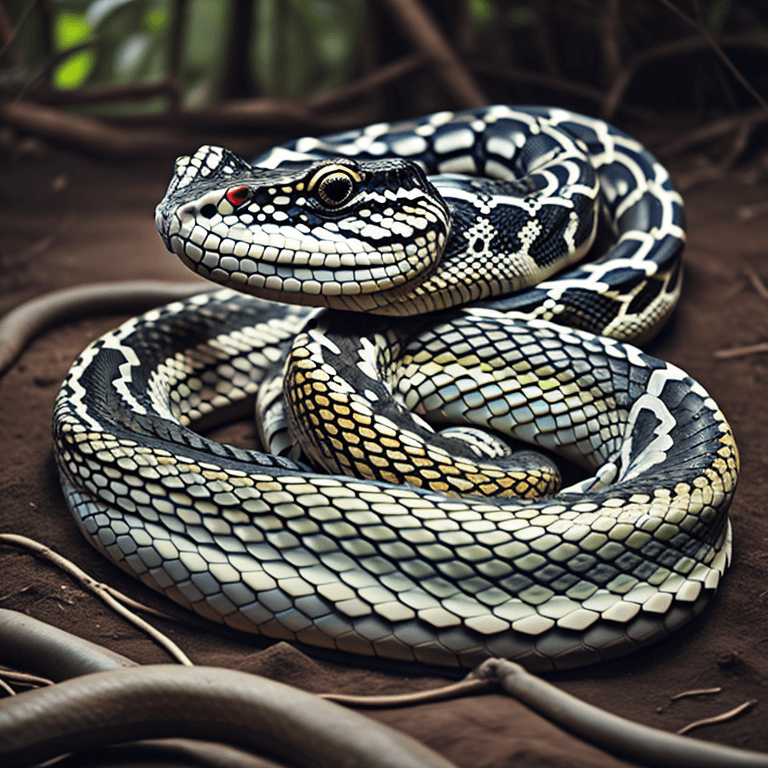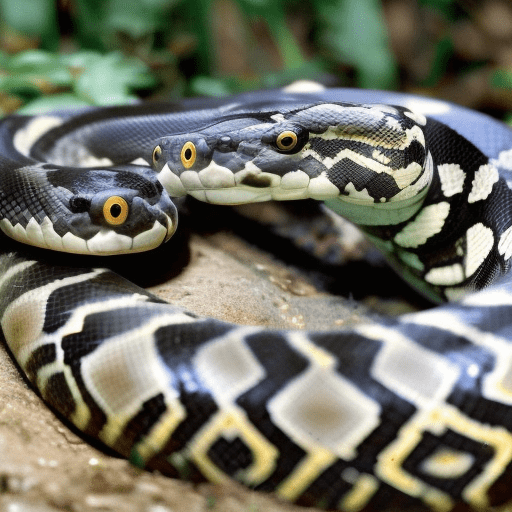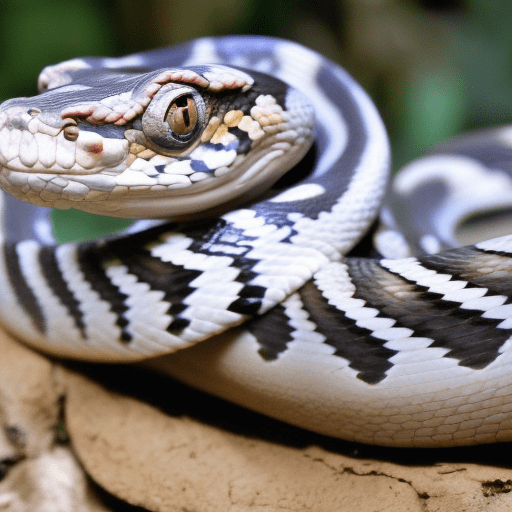White-Lipped Pythons: Seriously Cool Snakes!
Ever heard of a species of snake with glowing scales and bright white lips? Say hello to the white-lipped python! This awesome snake, a member of the family Pythonidae, lives in New Guinea and its nearby islands.
These snakes are a non venomous snake, which means they don’t inject poison when they bite. People who love reptiles think this python species is super cool, and you will too!
In this post, we’ll check out everything that makes this snake so amazing, from where it lives and what it eats, to how it acts and how to take care of one. Get ready to learn about a seriously cool snake! (You can even toggle the table of contents to jump around!)
What is a white lipped python?
Meet the white lipped python! The scientific name for it is Leiopython albertisii. This member of genus python lives in New Guinea and parts of Indonesia.
Unlike the largest snake in the world, the reticulated python (Malayopython reticulatus), the white-lipped python is smaller. White-lipped pythons are usually 4 to 6 feet long, but some can grow longer than 8 feet. This would make them medium length on average, compared to large species of pythons.
This python has a pale yellow or green body with darker stripes and a bright white ring around its mouth. That’s the reason people call it a white-lipped python!
These pythons usually hang out on the rainforest floor where it’s humid, but they can climb trees too!
Similar to Indian pythons (python molurus), white lipped pythons are carnivores, which means they eat meat. They’re super sneaky hunters and go after small mammals like rats and possums. They’re amazing climbers and fierce hunters on the ground.
A scientist discovered this large reptile way back in 1878. He’s a large snake, but don’t worry, he’s not venomous (it doesn’t have poisonous fangs). Oh, and they’re awesome swimmers too! You might spot one near a swamp or marsh.
(Want to learn more? You can always Wikipedia: The free encyclopedia!)

Here are some key facts about the white lipped python:
- Name: Scientists call it Leiopython albertisii. People also call it the white-lipped python.
- Location: It lives in New Guinea.
- Venom: It’s a non-venomous python, so it doesn’t have poisonous fangs.
- Size: Adult white-lipped pythons are usually 4 to 6 feet long, but some can grow longer than 8 feet.
- Appearance: Their scales can be tan, brown, or reddish-brown. They have distinctive white or yellow markings on their lips, chin, and belly. Some have dark spots.
- Hunting: This python hunts at night. It ambushes and constricts its prey, which includes animals like birds, bats, and rodents.
- Reproduction: Females lay eggs in clutches of 6 to 23 and coil around them until they hatch.
- Habitat: White-lipped pythons live in various forests in New Guinea.
- Abilities: They are good at climbing trees and swimming.
- Threats: People are capturing them for the pet trade, and they are losing their habitat. This is causing their numbers to decline.
- Pets: Some people keep them as pets, but they have complex needs.
- Temperament: They are generally docile but can bite or constrict if they feel threatened. Be careful during breeding season.

You might not have heard of the white-lipped python, but it’s a fascinating snake! The white-lipped python is not as well-known as the African rock python (Python sebae). Yet, it remains an incredible and fascinating large python.
There aren’t as many of these pythons in the wild anymore, but you can still find them in zoos and with people who keep them as pets. Be careful when you pick up this python because it can squeeze quite hard. Think of it like the blood pressure cuff at the doctor’s office.
Explain it to a child
White Lipped Pythons are pretty, shimmering snakes living in New Guinea. They have no poison. Their bodies can be different shades of brown, yellow, grey, and green. They have white or cream stripes running along the sides.
These pythons have a light-colored stripe by their eyes that makes them look different from other pythons.
How Large is a white lipped python?

These magnificent creatures can stretch up to an impressive six feet in length. These pythons are pretty sizable, but they’re also thinner and lighter than other types of pythons. Ball pythons tend to be smaller, to compare.
These pythons need a lot of space to move around, so their tanks should be larger and have lots of places to climb.
How long can a white lipped python live?
How long a white lipped python can live is something many potential owners don’t think of, and it turns out they should.
If you have a pet white-lipped python, it might live for about 20 years, so you’ll need to take care of it for a long time.
Where do white lipped pythons live?
These pythons live in lots of different places, like rainforests, woodlands, and even near rivers.
When it’s dry out, these pythons like to hang out in shady spots with lots of plants.
As good climbers, white lipped pythons often seek out shade under ledges or rocks i to regulate their body temperature.
These pythons are great swimmers! Sometimes they even swim between islands when there are floods.
Are white lipped pythons aggressive?
White lipped pythons can be calm and docile

These pythons aren’t usually aggressive, but they might bite if you scare them.
Before you get a pet python, you should learn about how they act and talk to experts.
If you hang out with your python and feed it regularly, it will probably stay friendly.
Are white lipped pythons good pets?
Some people keep these pythons as pets, but they can be hard to take care of.
- You have to pay close attention to this python and make sure it has the right kind of home.
- If you take good care of your white lipped python, it can be a good pet.
People like to keep white-lipped pythons as pets because they are pretty and usually calm.
What do white lipped pythons eat?

These snakes eat meat. They mostly eat small animals like birds, bats, rats, and sometimes lizards or frogs. They typically only eat large prey during a shortage of other options.
What’s more, these pythons love eating eggs, both from chickens and other reptiles, which they will often hunt at night.
White-lipped pythons can eat lots of different things!
How to take care of white lipped pythons?
You need to do a few important things to keep these pythons happy and healthy. An important to consider is to make sure the tank is the right temperature and humidity for your python.
White-lipped pythons need a warm tank, with one side around 85 degrees and the other around 95 degrees. These pythons also need their tank to be humid, so you have to spray it with water often.
Adult white lipped pythons need large tanks with strong branches for climbing.
You should feed your white-lipped python 1 or 2 small animals every week or so. Make sure to take out any food they don’t eat.
Rounding out expert care is ensuring that your python has access to clean, filtered water.
You must take good care of them if you have one as a pet and to protect them in the wild. By learning about and respecting these snakes, we can help make sure they stick around for a long, long time.
By providing these basic necessities you can ensure that your white lipped python stays healthy and contented for years to come!
White-Lipped Pythons: Respect the Awesome!
White-lipped pythons are awesome snakes! They’re beautiful, smart, and totally unique. We hope this post helped you learn more about white-lipped pythons!
In summary, the white-lipped python is a large, attractive constrictor living in New Guinea.
White Lipped Pythons are a neat exotic pet that won’t consume too much space. Compared to larger Burmese Pythons, Reticulated Pythons, or African Rock Python specimens, the White Lipped Python is fairly easy. Just remember not to underestimate their occasional defensive behaviors when caged!
Important Note: Important Note: White-lipped pythons are quite interesting! However, some pythons can cause issues if they escape into the wild. They can become an invasive species.
For example, the Burmese python has caused problems in the Everglades National Park in South Florida. Always research local laws and regulations before getting any kind of pet snake.
Article Sources
Jacks of Science sources the most authoritative, trustworthy, and highly recognized institutions for our article research. Learn more about our Editorial Teams process and diligence in verifying the accuracy of every article we publish.
